Get free scan and check if your device is infected.
Remove it nowTo use full-featured product, you have to purchase a license for Combo Cleaner. Seven days free trial available. Combo Cleaner is owned and operated by RCS LT, the parent company of PCRisk.com.
What is DocuSign email virus?
It is another spam email campaign used to proliferate a high-risk trojan called TrickBot. Developers send thousands of emails stating that users have received a "secure" document and must review and sign it. This is a scam - the opened MS Word document will stealthily download and install the TrickBot trojan.
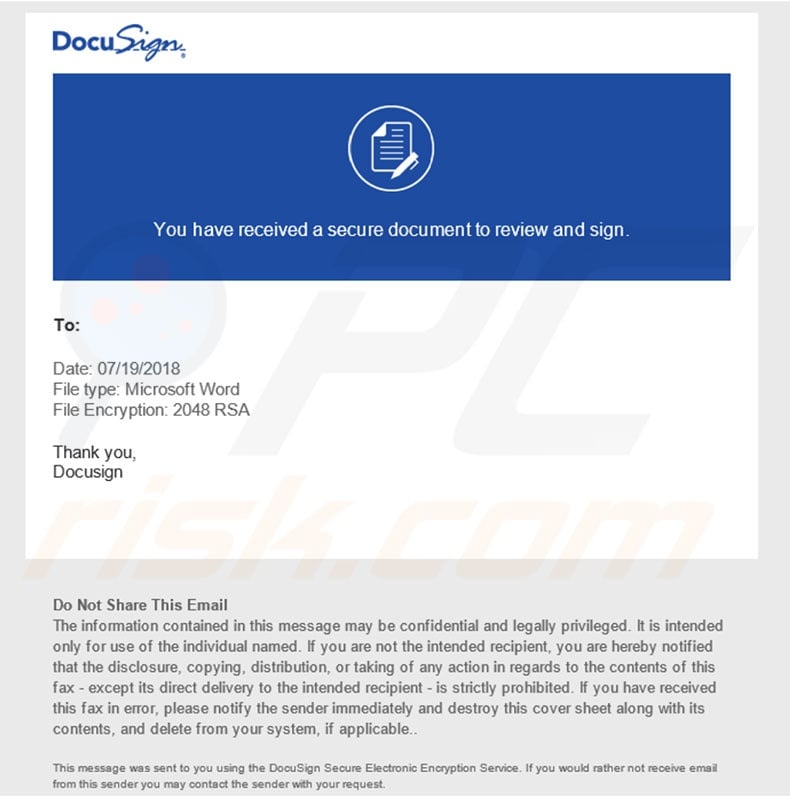
DocuSign malspam overview
The email essentially states that users must electronically sign documents, however, this is a simple attempt to trick them into opening malicious documents that download and install malware. Note that the email contains the logo of DocuSign, a legitimate company. This is very common amongst cyber criminals.
They register email addresses and domains by including names of popular companies and governmental agencies. This is done to give the impression of legitimacy - it is much simpler to trick users into opening documents received from familiar names.
TrickBot is high-risk trojan designed to gather personal information. Immediately after infiltration, it hijacks browsers and modifies visited website content so that entered logins/passwords are saved on a remote server controlled by cyber criminals.
The criminals can then gain access to users' personal accounts (social networks, emails, banks, etc.) Therefore, the presence of a malware such as TrickBot might lead to serious privacy issues and significant financial loss.
If you have recently opened emails distributed via the "DocuSign Email Virus" spam campaign, you should immediately scan the system with a reputable anti-virus/anti-spyware suite and eliminate all threats.
| Name | DocuSign spam |
| Threat Type | Trojan, Password stealing virus, Banking malware, Spyware |
| Symptoms | Trojans are designed to stealthily infiltrate victim's computer and remain silent thus no particular symptoms are clearly visible on an infected machine. |
| Distribution methods | Infected email attachments, malicious online advertisements, social engineering, software cracks. |
| Damage | Stolen banking information, passwords, identity theft, victim's computer added to a botnet. |
| Malware Removal (Windows) |
To eliminate possible malware infections, scan your computer with legitimate antivirus software. Our security researchers recommend using Combo Cleaner. Download Combo CleanerTo use full-featured product, you have to purchase a license for Combo Cleaner. 7 days free trial available. Combo Cleaner is owned and operated by RCS LT, the parent company of PCRisk.com. |
Examples of Trojans
There are a number of trojans similar to TrickBot including, for example, Adwind, Emotet, and FormBook. Most are distributed using spam email campaigns. In addition, these viruses typically have identical behavior: they collect information.
In some cases, however, trojans also proliferate other high-risk viruses, such as ransomware. In any case, these viruses pose a significant threat to your privacy and Internet browsing safety.
How did DocuSign Email Virus infect my computer?
As mentioned above, "DocuSign Email Virus" distributes a malicious Microsoft Word document that, once opened, asks users to enable macro commands. By complying, users grant permission for macro command within the document to run commands that stealthily download and install malware. This malware distribution method does, however, have a major flaw.
The attachment is unable to download malware if it is opened using any software other than MS Word. If the file is opened using another app that is capable of reading .doc format, TrickBot will not be downloaded. In addition, TrickBot targets only Microsoft Windows Operating System and users of other platforms are safe.
How to avoid installation of malware?
To prevent this situation, be very cautious when browsing the Internet. Carefully analyze each email attachment received. Files that seem irrelevant and those received from suspicious/unrecognizable email addresses should never be opened. They should be deleted immediately, without reading. In addition, have a reputable anti-virus/anti-spyware suite installed and running.
More recent versions (2010 and above) of MS Office open newly-downloaded documents in "Protected View" mode. This prevents malicious attachments from downloading and installing viruses. Therefore, using older MS Office versions is risky and not recommended.
The main reasons for computer infections are poor knowledge and careless behavior. The key to safety is caution. If you have already opened the "DocuSign Email Virus" attachment, we recommend running a scan with Combo Cleaner Antivirus for Windows to automatically eliminate infiltrated malware.
Text presented in the "DocuSign Email Virus" email message:
You have received a secure document to review and sign.
File type: Microsoft Word
File Encryption: 2048 RSA
Do Not Share This Email
The information contained in this message may be confidential and legally privileged. It is intended only for use of the individual named. If you are not the intended recipient, you are hereby notified that the disclosure, copying, distribution, or taking of any action in regards to the contents of this fax – except its direct delivery to the intended recipient – is strictly prohibited. If you have received this fax in error, please notify the sender immediately and destroy this cover sheet along with its contents, and delete from your system, if applicable..
This message was sent to you using the DocuSign Secure Electronic Encryption Service. If you would rather not receive email from this sender you may contact the sender with your request.
Malicious attachment distributed via "DocuSign Email Virus" spam campaign:
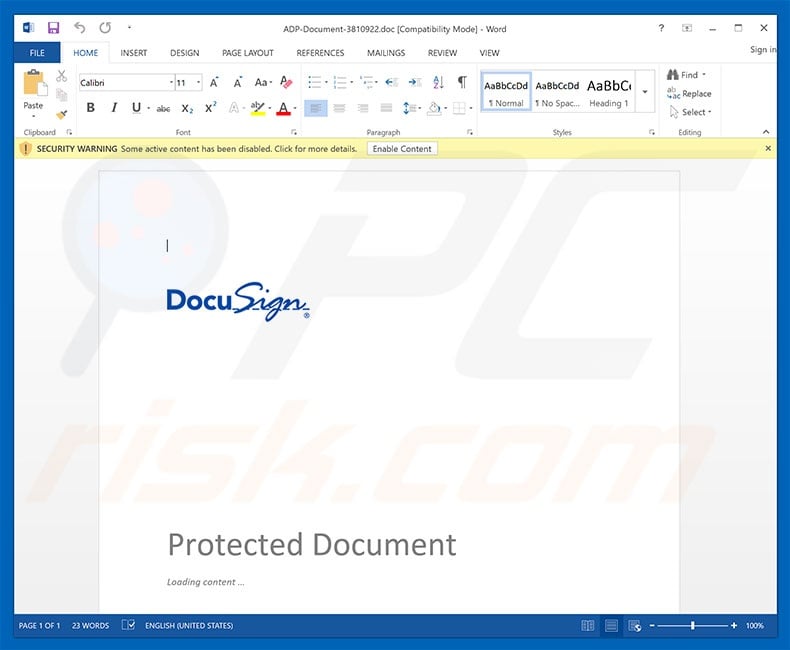
Another variant of DocuSign spam email (if potential victims click on "View Document" button - this variant downloads a malicious file invoice_958306.xls - a macros malware that infect computers with trojans):
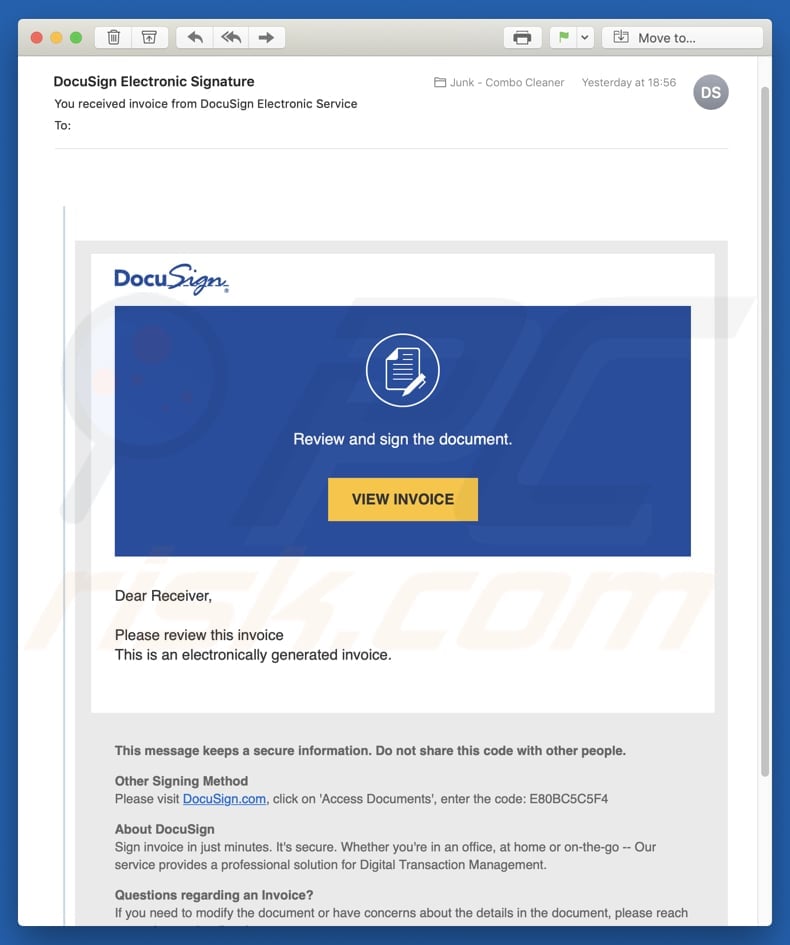
Text presented in this fake email:
Subject: You received invoice from DocuSign Electronic Service
DocuSign
Review and sign the document.
Dear Receiver,
Please review this invoice
This is an electronically generated invoice.
This message keeps a secure information. Do not share this code with other people.
Other Signing Method
Please visit DocuSign.com, click on 'Access Documents', enter the code: E80BC5C5F4
About DocuSign
Sign invoice in just minutes. It's secure. Whether you're in an office, at home or on-the-go -- Our service provides a professional solution for Digital Transaction Management.
Questions regarding an Invoice?
If you need to modify the document or have concerns about the details in the document, please reach out to the sender directly.
If you cannot see an invoice, please see the Help with Signing page on our support .
This message was sent to you by DocuSign Electronic Signature Service.
Screenshot of a malicious DocuSign-themed MS Excel document ("Bharat1085113_.xls") designed to inject Ursnif (Gozi) malware into the system:
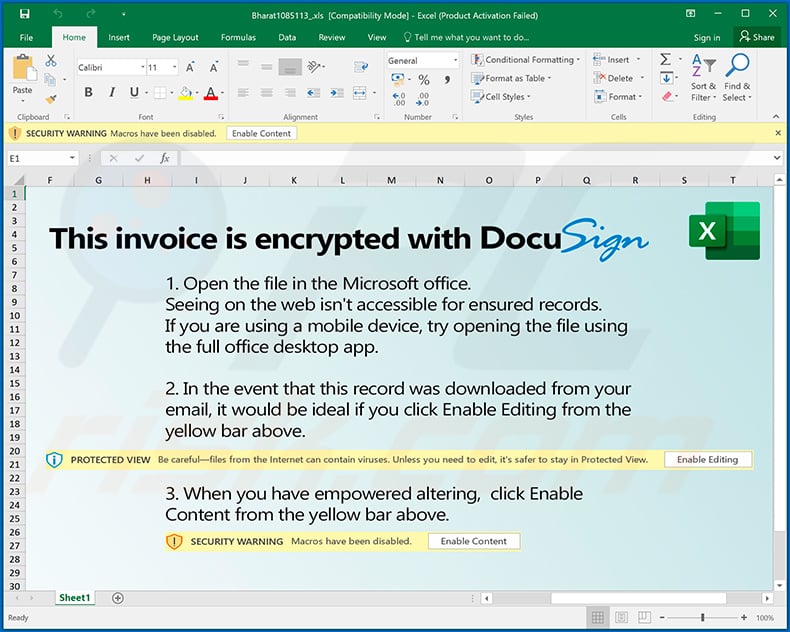
Another malicious Microsoft Word document distributed via DocuSign spam campaign. This document spreads Hancitor trojan:
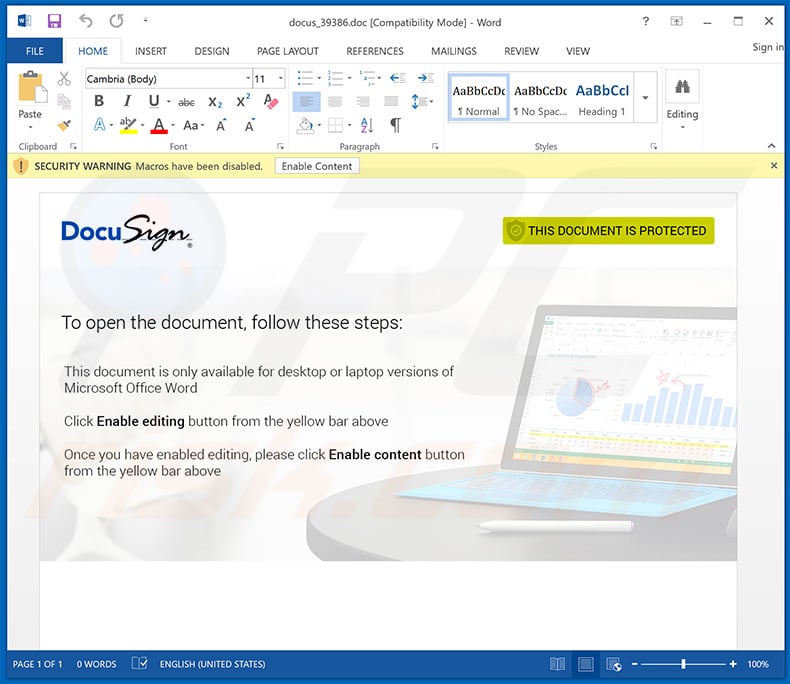
Appearance of yet another DocuSign-themed spam email used to spread malware:
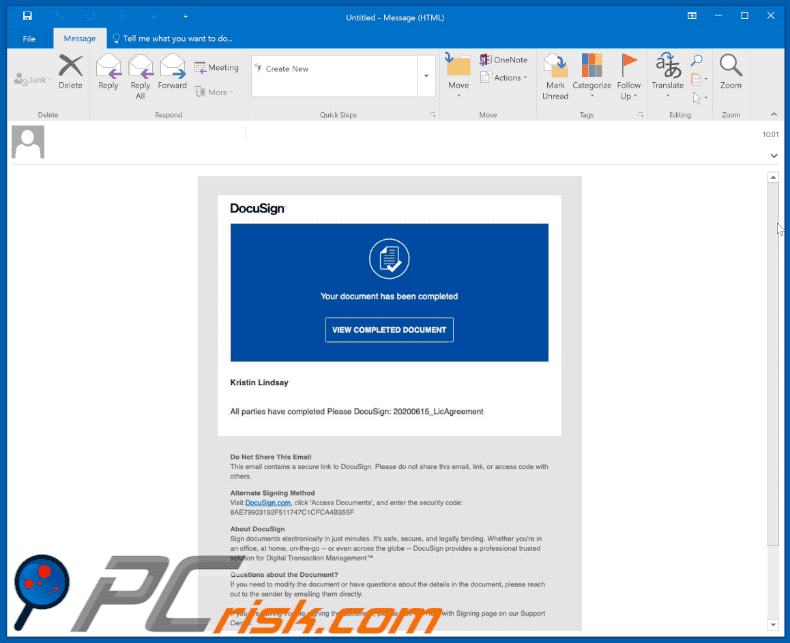
Appearance of a DocuSign-themed malicious MS Excel document designed to inject TrickBot malware into the system:
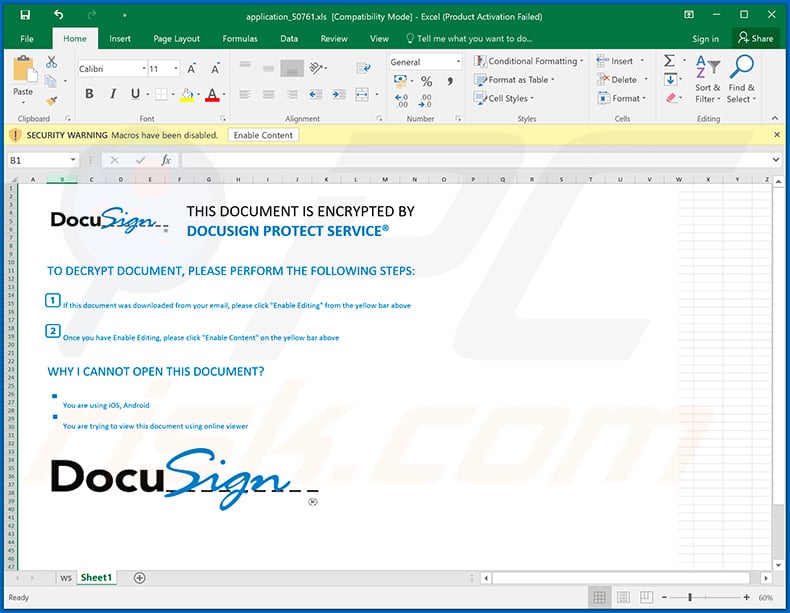
Another example of DocuSign-themed spam email used to promote a phishing website:
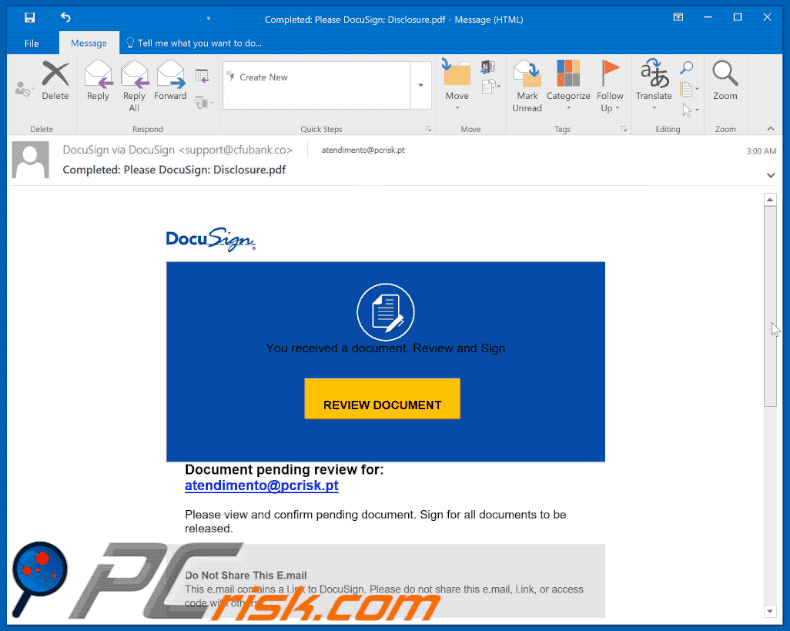
Text presented within:
Subject: Completed: Please DocuSign: Disclosure.pdf
You received a document. Review and SignREVIEW DOCUMENT
Document pending review for:
-
Please view and confirm pending document. Sign for all documents to be released.
Do Not Share This E.mail
This e.mail contains a l.ink to DocuSign. Please do not share this e.mail, l.ink, or access code with others.
Alternate Signing Method
Visit DocuSign.com, click 'Access Documents', and enter the code:
55A4D6A585274E07AE23ABDE595F2
About DocuSign
Sign documents electronically in just minutes. It's safe, secure, and legally binding. Whether you're in an office, at home, on-the-go -- or even across the globe -- DocuSign provides a professional trusted answer for Digital Transaction Management™.
Questions about the Document?
If you need to modify the document or have questions about the details in the document, please reach out to the sender by emailing them directly.If you are having trouble signing the document, please go to the Help with Signing page on our Support Center.
Get the DocuSign App
This message was sent to you - via DocuSign Electronic Signature Service. If you would rather not receive e.mail from this sender you may contact the sender with your request.
Screenshot of the promoted phishing site:
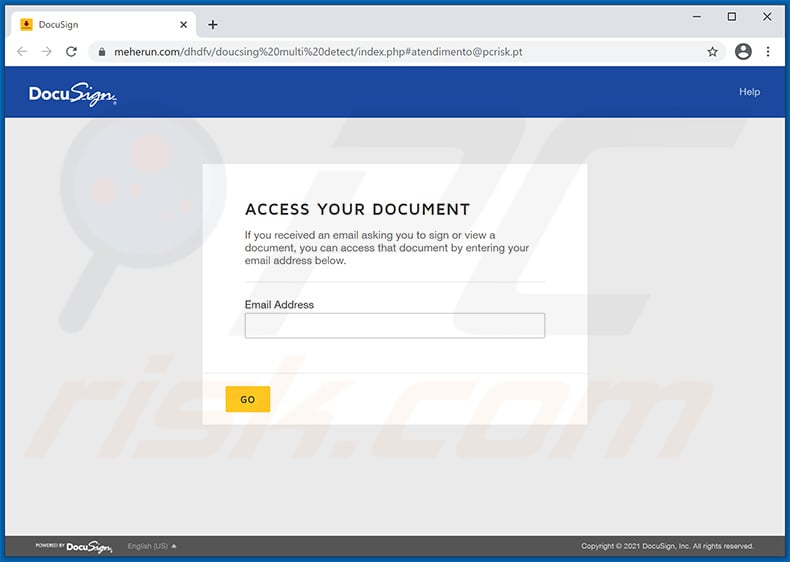
Yet another example of DocuSign-themed spam email used to spread Agent Tesla malware:
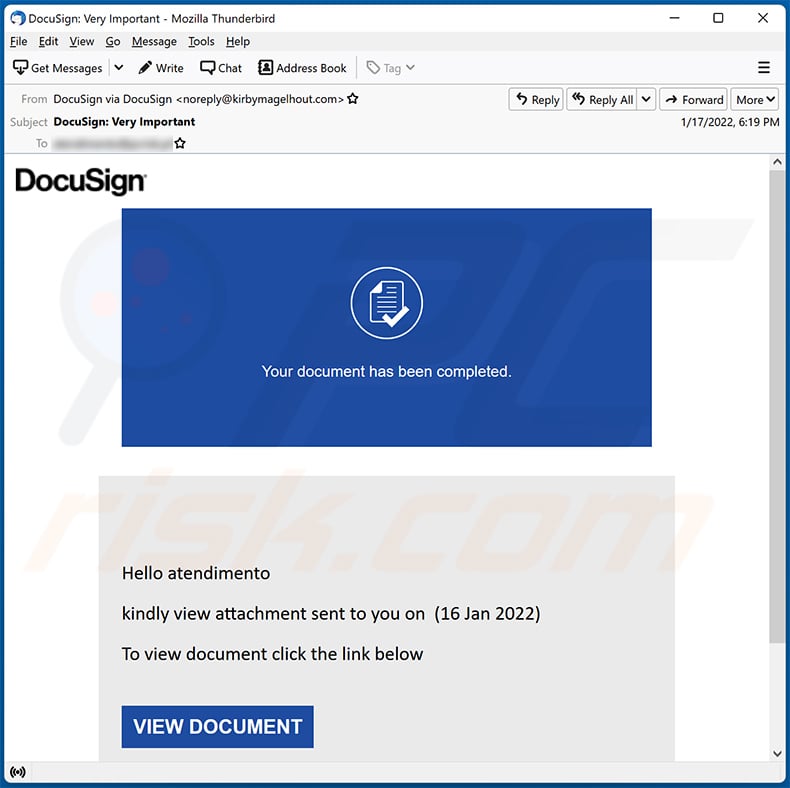
Text presented within:
DocuSign
Your document has been completed.Hello -
kindly view attachment sent to you on (16 Jan 2022)
To view document click the link below
VIEW DOCUMENT
Yet another example of DocuSign-themed spam email promoting a phishing site:
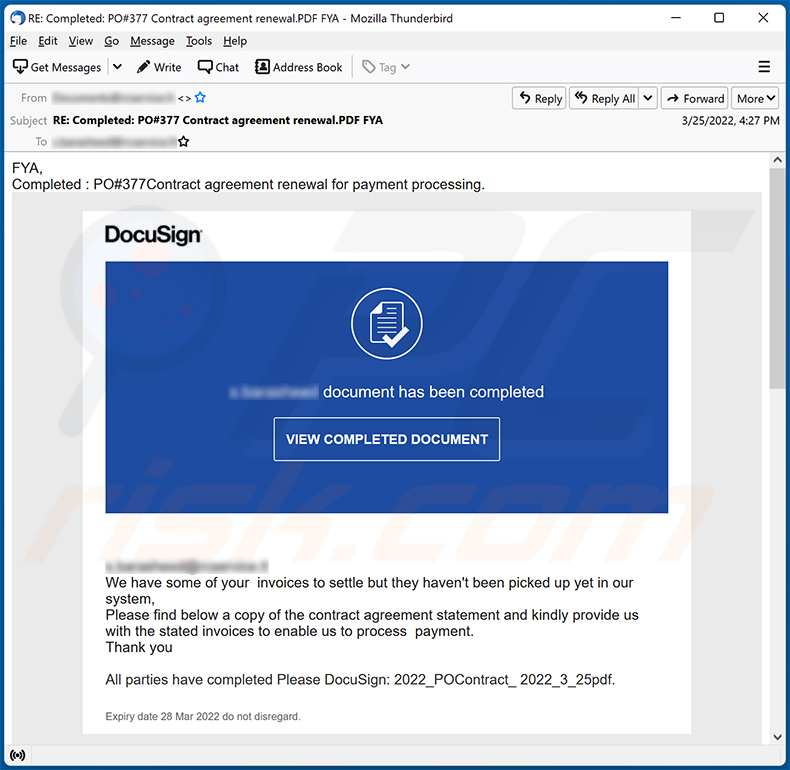
Text presented within:
Subject: RE: Completed: PO#377 Contract agreement renewal.PDF FYA
FYA,
Completed : PO#377Contract agreement renewal for payment processing.
DocuSign******** document has been completed
VIEW COMPLETED DOCUMENT
********
We have some of your invoices to settle but they haven't been picked up yet in our system,
Please find below a copy of the contract agreement statement and kindly provide us with the stated invoices to enable us to process payment.
Thank youAll parties have completed Please DocuSign: 2022_POContract_ 2022_3_25pdf.
Expiry date 28 Mar 2022 do not disregard.
Alternate Signing Method
Move this message to inbox, click 'View Completed Documents', and enter ******** and PassAbout DocuSign
Sign documents electronically in just minutes. It's safe, secure, and legally binding. Whether you're in an office, at home, on-the-go -- or even across the globe -- DocuSign provides a professional trusted solution for Digital Transaction Management™.Questions about the Document?
If you need to modify the document or have questions about the details in the document, please reach out to the sender by emailing them directly.Stop receiving this email
Report this email or read more about Declining to sign and Managing notifications.If you are having trouble signing the document, please visit the Help with Signing page on our Support Center.
Download the DocuSign App
This message was sent to you by Vicki Seekford who is using the DocuSign Electronic Signature Service. If you would rather not receive email from this sender you may contact the sender with your request.
--
Thanks for your business!
Tauri Builders Inc.Regards,
Jean Delacroix M.
Operations Manager
Tauri Builders Inc.
Concrete & Drywall
AB :587.988.9914
BC :604.202.0627
Screenshot of the promoted phishing site:
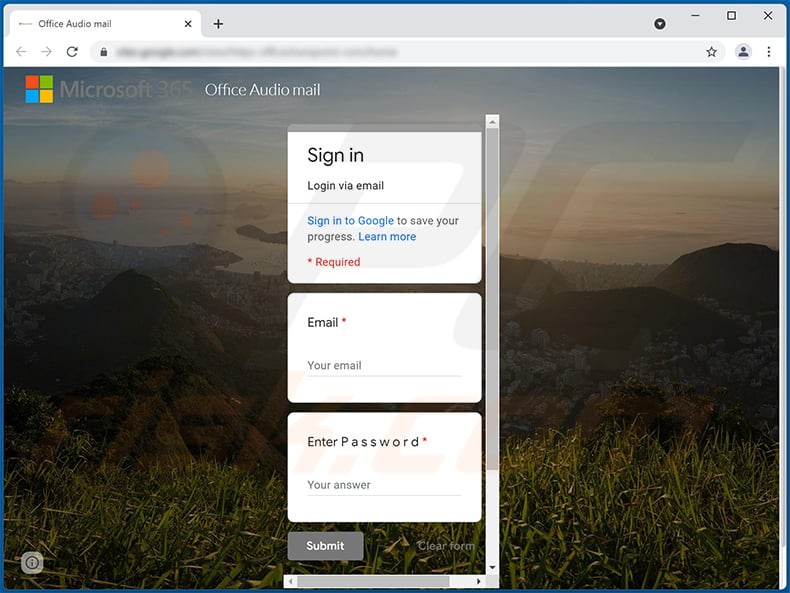
Another example of DocuSign-themed spam email promoting a phishing site:
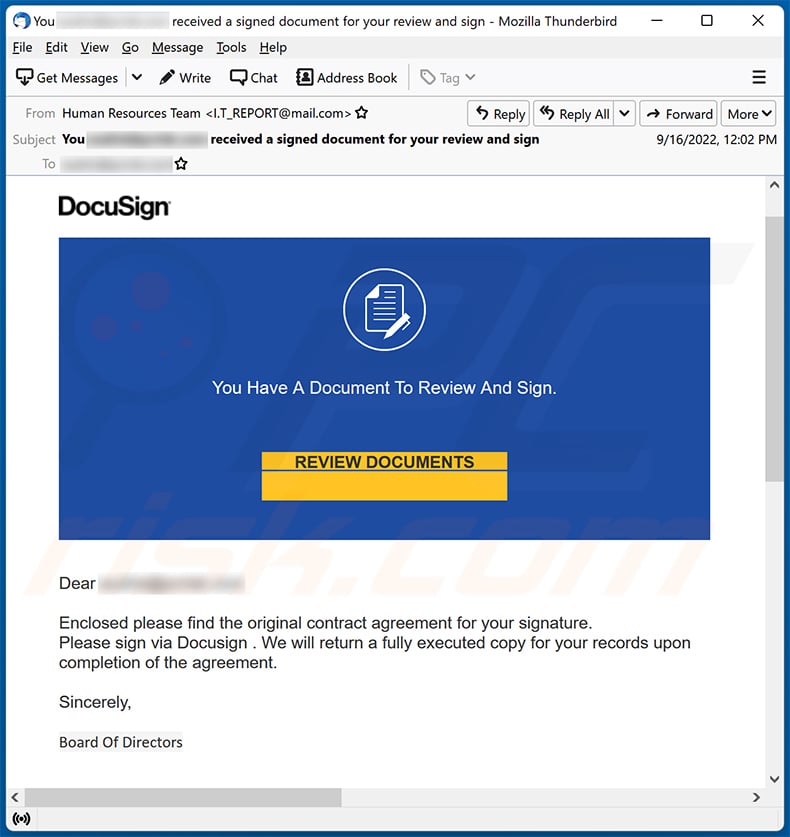
Text presented within:
Subject: You - received a signed document for your review and sign
DocuSign
You Have A Document To Review And Sign.
REVIEW DOCUMENTS
Dear -
Enclosed please find the original contract agreement for your signature. Please sign via Docusign . We will return a fully executed copy for your records upon completion of the agreement.
Sincerely,
Board Of Directors
Screenshot of the promoted phishing site:
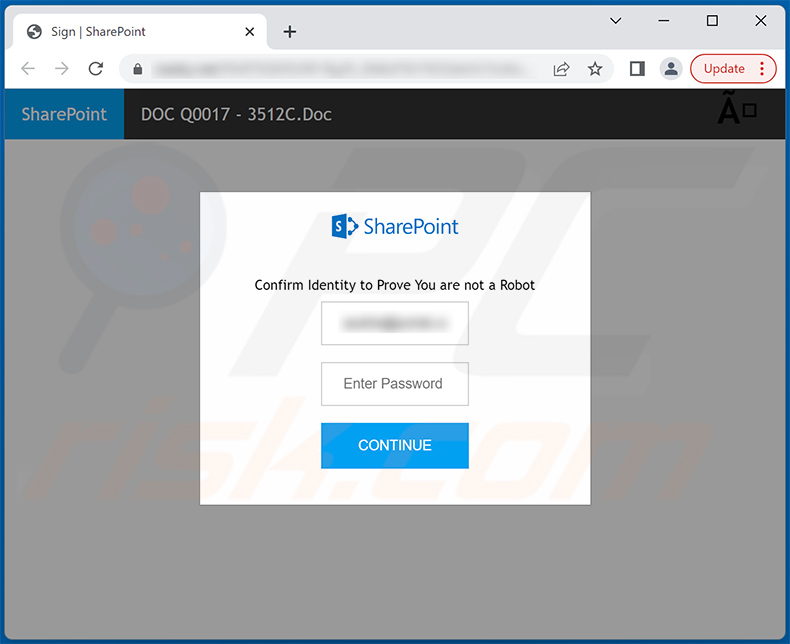
Another example of DocuSign-themed spam email promoting a phishing site:
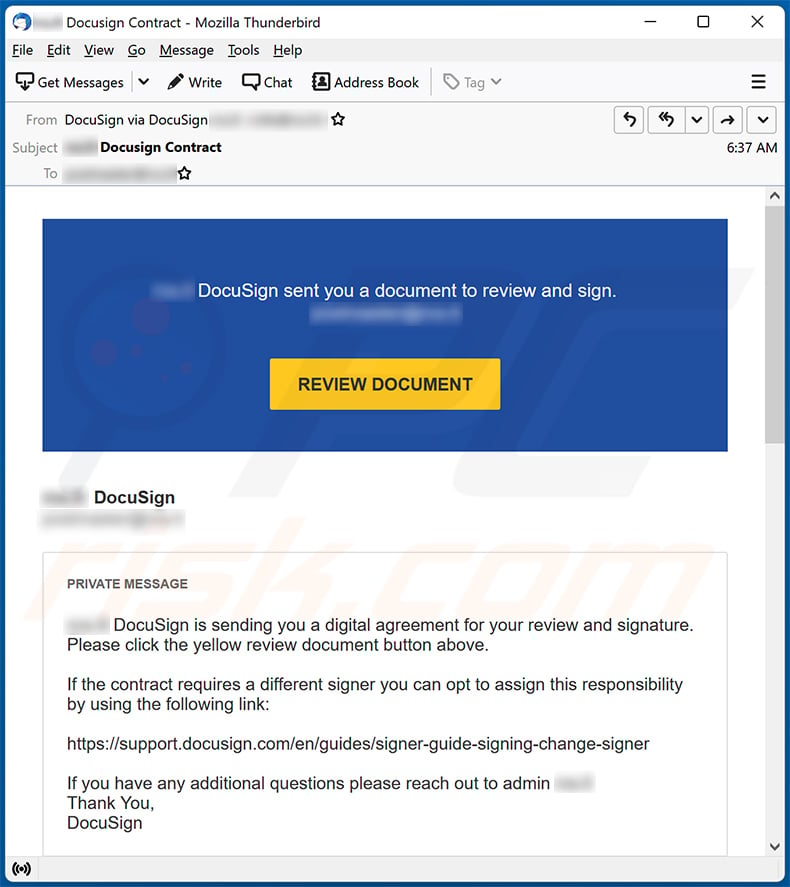
Text presented within:
Subject: ******** Docusign Contract
******** DocuSign sent you a document to review and sign.
********
REVIEW DOCUMENT
******** DocuSign
********
PRIVATE MESSAGE
******** DocuSign is sending you a digital agreement for your review and signature. Please click the yellow review document button above.If the contract requires a different signer you can opt to assign this responsibility by using the following link:
-
If you have any additional questions please reach out to admin ********
Thank You,
DocuSign
Screenshot of the promoted phishing site:
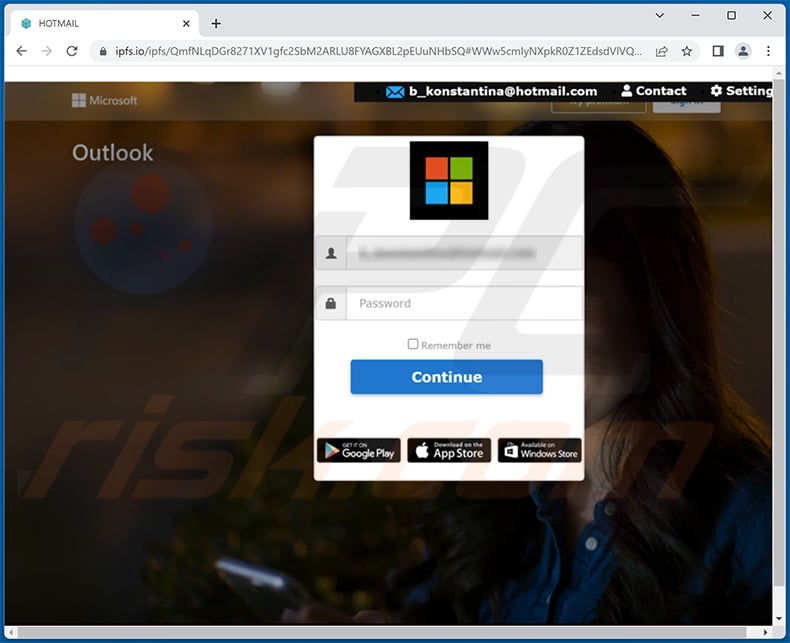
Another example of DocuSign-themed spam email promoting a phishing site:
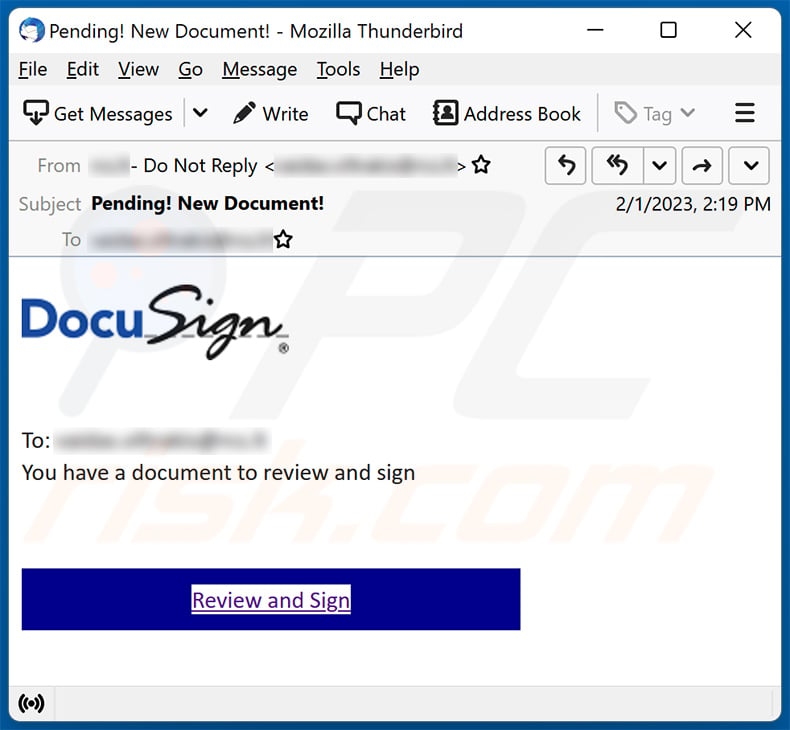
Text presented within:
Subject: Pending! New Document!
DocuSignTo: -
You have a document to review and sign
Review and Sign
Screenshot of the promoted phishing site:
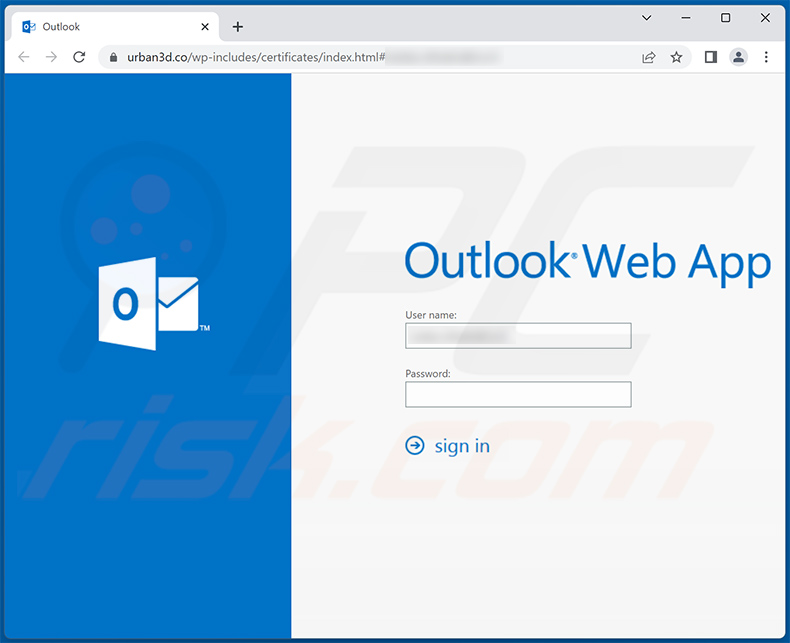
Instant automatic malware removal:
Manual threat removal might be a lengthy and complicated process that requires advanced IT skills. Combo Cleaner is a professional automatic malware removal tool that is recommended to get rid of malware. Download it by clicking the button below:
DOWNLOAD Combo CleanerBy downloading any software listed on this website you agree to our Privacy Policy and Terms of Use. To use full-featured product, you have to purchase a license for Combo Cleaner. 7 days free trial available. Combo Cleaner is owned and operated by RCS LT, the parent company of PCRisk.com.
Quick menu:
- What is DocuSign spam?
- Types of malicious emails.
- How to spot a malicious email?
- What to do if you fell for an email scam?
Types of malicious emails:
![]() Phishing Emails
Phishing Emails
Most commonly, cybercriminals use deceptive emails to trick Internet users into giving away their sensitive private information, for example, login information for various online services, email accounts, or online banking information.
Such attacks are called phishing. In a phishing attack, cybercriminals usually send an email message with some popular service logo (for example, Microsoft, DHL, Amazon, Netflix), create urgency (wrong shipping address, expired password, etc.), and place a link which they hope their potential victims will click on.
After clicking the link presented in such email message, victims are redirected to a fake website that looks identical or extremely similar to the original one. Victims are then asked to enter their password, credit card details, or some other information that gets stolen by cybercriminals.
![]() Emails with Malicious Attachments
Emails with Malicious Attachments
Another popular attack vector is email spam with malicious attachments that infect users' computers with malware. Malicious attachments usually carry trojans that are capable of stealing passwords, banking information, and other sensitive information.
In such attacks, cybercriminals' main goal is to trick their potential victims into opening an infected email attachment. To achieve this goal, email messages usually talk about recently received invoices, faxes, or voice messages.
If a potential victim falls for the lure and opens the attachment, their computers get infected, and cybercriminals can collect a lot of sensitive information.
While it's a more complicated method to steal personal information (spam filters and antivirus programs usually detect such attempts), if successful, cybercriminals can get a much wider array of data and can collect information for a long period of time.
![]() Sextortion Emails
Sextortion Emails
This is a type of phishing. In this case, users receive an email claiming that a cybercriminal could access the webcam of the potential victim and has a video recording of one's masturbation.
To get rid of the video, victims are asked to pay a ransom (usually using Bitcoin or another cryptocurrency). Nevertheless, all of these claims are false - users who receive such emails should ignore and delete them.
How to spot a malicious email?
While cyber criminals try to make their lure emails look trustworthy, here are some things that you should look for when trying to spot a phishing email:
- Check the sender's ("from") email address: Hover your mouse over the "from" address and check if it's legitimate. For example, if you received an email from Microsoft, be sure to check if the email address is @microsoft.com and not something suspicious like @m1crosoft.com, @microsfot.com, @account-security-noreply.com, etc.
- Check for generic greetings: If the greeting in the email is "Dear user", "Dear @youremail.com", "Dear valued customer", this should raise suspiciousness. Most commonly, companies call you by your name. Lack of this information could signal a phishing attempt.
- Check the links in the email: Hover your mouse over the link presented in the email, if the link that appears seems suspicious, don't click it. For example, if you received an email from Microsoft and the link in the email shows that it will go to firebasestorage.googleapis.com/v0... you shouldn't trust it. It's best not to click any links in the emails but to visit the company website that sent you the email in the first place.
- Don't blindly trust email attachments: Most commonly, legitimate companies will ask you to log in to their website and to view any documents there; if you received an email with an attachment, it's a good idea to scan it with an antivirus application. Infected email attachments are a common attack vector used by cybercriminals.
To minimise the risk of opening phishing and malicious emails we recommend using Combo Cleaner Antivirus for Windows.
Example of a spam email:

What to do if you fell for an email scam?
- If you clicked on a link in a phishing email and entered your password - be sure to change your password as soon as possible. Usually, cybercriminals collect stolen credentials and then sell them to other groups that use them for malicious purposes. If you change your password in a timely manner, there's a chance that criminals won't have enough time to do any damage.
- If you entered your credit card information - contact your bank as soon as possible and explain the situation. There's a good chance that you will need to cancel your compromised credit card and get a new one.
- If you see any signs of identity theft - you should immediately contact the Federal Trade Commission. This institution will collect information about your situation and create a personal recovery plan.
- If you opened a malicious attachment - your computer is probably infected, you should scan it with a reputable antivirus application. For this purpose, we recommend using Combo Cleaner Antivirus for Windows.
- Help other Internet users - report phishing emails to Anti-Phishing Working Group, FBI’s Internet Crime Complaint Center, National Fraud Information Center and U.S. Department of Justice.
Frequently Asked Questions (FAQ)
Why did I receive this email?
This letter was most likely sent to a large number of people. Usually, such emails are not personalized - all recipients receive the same email.
I have downloaded and opened a file attached to this email, is my computer infected?
Threat actors behind this malspam campaign use malicious MS Office documents to distribute TrickBot. Recipients infect computers after opening those documents and enabling macros commands. Your computer is not infected if you have not enabled macros commands after opening a malicious document.
I have read the email but didn't open the attachment, is my computer infected?
No, opening emails but keeping their contents unopened is completely harmless.
Will Combo Cleaner remove malware infections that were present in email attachment?
Yes, Combo Cleaner will remove malware from the operating system. This application can detect almost all known malware. If a computer is infected with high-end malware, it must be scanned using a full system scan. Usually, high-end malware hides deep in the system.
Share:

Tomas Meskauskas
Expert security researcher, professional malware analyst
I am passionate about computer security and technology. I have an experience of over 10 years working in various companies related to computer technical issue solving and Internet security. I have been working as an author and editor for pcrisk.com since 2010. Follow me on Twitter and LinkedIn to stay informed about the latest online security threats.
PCrisk security portal is brought by a company RCS LT.
Joined forces of security researchers help educate computer users about the latest online security threats. More information about the company RCS LT.
Our malware removal guides are free. However, if you want to support us you can send us a donation.
DonatePCrisk security portal is brought by a company RCS LT.
Joined forces of security researchers help educate computer users about the latest online security threats. More information about the company RCS LT.
Our malware removal guides are free. However, if you want to support us you can send us a donation.
Donate
▼ Show Discussion